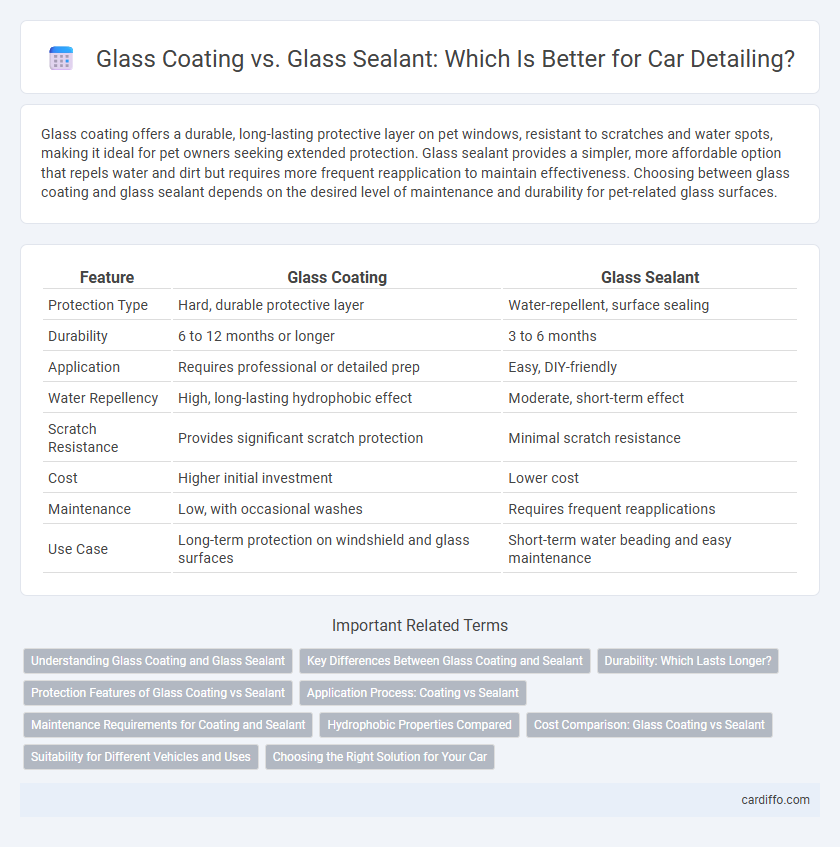Glass coating offers a durable, long-lasting protective layer on pet windows, resistant to scratches and water spots, making it ideal for pet owners seeking extended protection. Glass sealant provides a simpler, more affordable option that repels water and dirt but requires more frequent reapplication to maintain effectiveness. Choosing between glass coating and glass sealant depends on the desired level of maintenance and durability for pet-related glass surfaces.
Table of Comparison
| Feature | Glass Coating | Glass Sealant |
|---|---|---|
| Protection Type | Hard, durable protective layer | Water-repellent, surface sealing |
| Durability | 6 to 12 months or longer | 3 to 6 months |
| Application | Requires professional or detailed prep | Easy, DIY-friendly |
| Water Repellency | High, long-lasting hydrophobic effect | Moderate, short-term effect |
| Scratch Resistance | Provides significant scratch protection | Minimal scratch resistance |
| Cost | Higher initial investment | Lower cost |
| Maintenance | Low, with occasional washes | Requires frequent reapplications |
| Use Case | Long-term protection on windshield and glass surfaces | Short-term water beading and easy maintenance |
Understanding Glass Coating and Glass Sealant
Glass coating involves applying a durable, often nano-ceramic layer that chemically bonds to the surface, providing long-lasting protection against scratches, water spots, and UV damage. Glass sealant typically refers to a polymer-based product that creates a hydrophobic barrier, repelling water and contaminants but with a shorter lifespan compared to coatings. Understanding the chemical composition and bonding properties of glass coatings versus the surface-level protection of sealants is key to choosing the right product for enhanced clarity and durability.
Key Differences Between Glass Coating and Sealant
Glass coating forms a hard, durable layer that offers long-lasting protection against scratches, water spots, and UV damage, while glass sealant provides a thinner, less durable barrier primarily designed to repel water and dirt temporarily. The coating's chemical composition allows it to bond at a molecular level with the glass surface, enhancing clarity and resistance, whereas sealants typically sit on the surface and require more frequent reapplication. Glass coatings often have a lifespan of several months to years, compared to sealants that generally last only a few weeks to months depending on environmental conditions.
Durability: Which Lasts Longer?
Glass coating offers superior durability compared to glass sealant, often lasting up to 2-5 years due to its advanced chemical bonding properties. In contrast, glass sealants typically provide protection for 3 to 6 months before requiring reapplication. The enhanced longevity of glass coating makes it a preferred choice for long-term glass surface protection in automotive and architectural detailing.
Protection Features of Glass Coating vs Sealant
Glass coating provides a durable, chemical-resistant layer that offers long-lasting protection against water spots, UV rays, and environmental contaminants, significantly outperforming glass sealants in durability and hydrophobic properties. Glass sealants typically offer shorter-term protection by forming a thinner barrier that repels water and dirt but is more susceptible to wear and requires frequent reapplication. Advanced glass coatings enhance surface hardness and reduce surface energy, resulting in superior resistance to scratches and easier maintenance compared to conventional glass sealants.
Application Process: Coating vs Sealant
Glass coating application involves a precise process where a liquid polymer is spread evenly over the surface and cured to form a durable, protective layer resistant to scratches and contaminants. In contrast, glass sealant application is typically simpler, requiring the sealant to be applied and wiped off without curing, offering temporary water repellency and protection. Coatings generally demand professional application or controlled conditions to ensure bonding, while sealants can be applied quickly by hand for immediate, though less long-lasting, results.
Maintenance Requirements for Coating and Sealant
Glass coating requires less frequent maintenance compared to glass sealants due to its durable, hydrophobic layer that repels dirt and water effectively. Glass sealants need regular reapplication every few months to maintain their protective properties and prevent water spots or grime buildup. Proper upkeep of coatings involves periodic washing with pH-neutral cleaners, while sealants demand more consistent touch-ups to ensure lasting clarity and protection.
Hydrophobic Properties Compared
Glass coating offers superior hydrophobic properties compared to glass sealant, creating a longer-lasting water-repellent layer that enhances visibility during rain. Glass coatings chemically bond to the glass surface, providing durable protection against water, dirt, and contaminants, while glass sealants typically form a weaker, temporary barrier. The advanced nanotechnology in glass coatings ensures consistent beading and faster water runoff, significantly improving driving safety and reducing maintenance frequency.
Cost Comparison: Glass Coating vs Sealant
Glass coating typically costs between $100 and $200 per application due to advanced nanotechnology and longer durability, while glass sealants range from $30 to $80, offering a more budget-friendly but shorter-lasting solution. The investment in glass coating provides extended protection lasting up to 12 months, reducing the need for frequent reapplications common with sealants that last around 1 to 3 months. Choosing glass coating can be more cost-effective over time despite higher upfront fees, as it ensures superior hydrophobic properties and surface protection compared to traditional glass sealants.
Suitability for Different Vehicles and Uses
Glass coating offers superior durability and hydrophobic properties, making it ideal for high-end vehicles and those frequently exposed to harsh weather conditions. Glass sealants provide a more affordable, easier-to-apply option suitable for daily drivers and older vehicles requiring moderate protection. Both products enhance visibility and protect against contaminants, but glass coating is preferred for long-term performance and low maintenance.
Choosing the Right Solution for Your Car
Glass coating offers superior durability and hydrophobic properties that repel water and reduce dirt buildup, making it ideal for long-term protection and enhanced visibility. Glass sealant provides a cost-effective, easy-to-apply barrier that temporarily improves water repellency and surface resistance. Selecting the right solution depends on your desired maintenance frequency, budget, and performance expectations for your car's glass surfaces.
Glass Coating vs Glass Sealant Infographic

 cardiffo.com
cardiffo.com